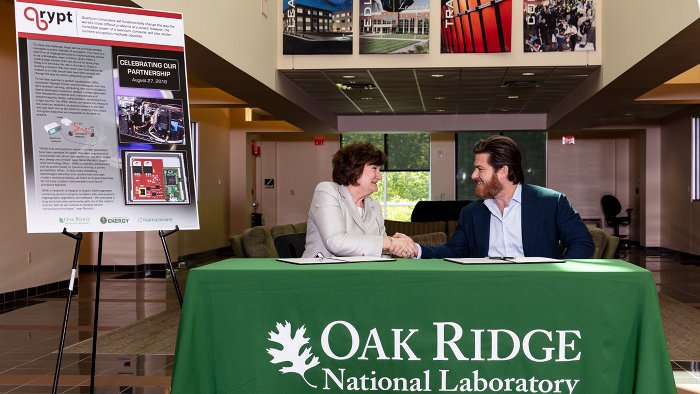
Development of Oak Ridge National Laboratory’s quantum random number generator began with basic components including an LED light, the source from which a field of quadrillions of photons are produced. The device can detect and measure the quantum statistics of photons present in the field and use each one as the basis for creating truly unique encryption keys that are impossible to decipher or predict. (Photo credit: Brian Williams/Oak Ridge National Laboratory, U.S. Department of Energy)
A company called Qrypt Inc. will incorporate a quantum random number generator developed by Oak Ridge National Laboratory into existing encryption techniques, strengthening cyber security, a press release said.
Qrypt has exclusively licensed the technology from ORNL, a U.S. Department of Energy laboratory. It’s intended to help defend against cyber attacks, including those posed by quantum computing.
Encryption uses codes or mathematical algorithms to make information such as messages or stored data unintelligible to unauthorized readers. Quantum computers make use of the quantum states of electrons or other particles to store and process information as quantum bits.
The press release said Qrypt will incorporate ORNL’s quantum random number generator into the company’s existing encryption platform. It will use inherent quantum randomness to create unique and unpredictable encryption keys enabling virtually impenetrable communications, the press release said.
“The advent of quantum computing offers a fundamentally new approach to solving some of the world’s most difficult and pressing problems,” it said. “However, quantum computing will also render current encryption methods obsolete and require a reimagined, quantum-based approach to protecting data.”
“The cryptography we have developed is based on true quantum sources of entropy and is mathematically proven to be unbreakable—even in theory,” said Denis Mandich, Qrypt’s chief technology officer at the company’s New York City office.
“Until recently, this class of technology was unavailable at the scale required to encrypt Internet-sized datasets,” Mandich said. “Simply relying on increasing the complexity of cryptographic algorithms has again proven to be a failing bet.”
ORNL’s research is integral to Qrypt’s hybrid approach: combining quantum physics hardware with post-quantum cryptographic algorithms and software.
“We anticipate a long and productive partnership with one of the nation’s premier labs as we continue to develop secure computing technologies,” Mandich said.
One method for successful, failsafe encryption will come from encoding messages with encryption keys that are truly random, the press release said. That is, there is no realistic chance the exact key sequence used could be generated more than once.
To harness quantum’s perfect randomness, ORNL co-inventor Raphael Pooser and his colleagues from the lab’s quantum sensing, computing, and communications teams developed a quantum random number generator that detects the presence and characteristics of electro-magnetic waves, called photons, streaming from a light source.
“A field of quadrillions of photons are produced and pass through a beam splitter,” Pooser said. “Different from other quantum random number generator technologies, our method does not require that we wait for a single photon to appear, but allows us to use the collective statistics of large numbers of them.”
The ORNL device can detect and measure the quantum statistics of photons present in the field and use each one as the basis for creating truly unique encryption keys that are impossible to decipher or predict.
“While true and quantum random number generators have been available for years, they were impractical to incorporate into server size appliances and their output was always very limited,” Mandich said.
ORNL’s scientific achievement can be proven based on quantum entropy, a purely probabilistic effect, he said.
“Many competing technologies advertise true randomness and pass modern statistical testing, yet there is no guarantee they do not have a pattern discoverable in the future,” Mandich said.
“Historically, patterns, predictability, and repetition are a critical flaw for many crypto systems, allowing them to fall to basic cryptanalysis,” he said.
Qrypt will incorporate ORNL’s technology into a suite of quantum-resistant encryption techniques and technologies, including a card or chip enabling quick encryption of vast datasets. Data protected by this technology will be secure against attack by quantum computers or any future computational device and developments in the mathematics of cryptanalysis.
Co-inventors of the ORNL quantum random number generator are Raphael Pooser, Travis Humble, Brian Williams, Bing Qi, and Benjamin Lawrie of the lab’s Quantum Information Science group, part of ORNL’s Computational Sciences and Engineering Division.
More information will be added as it becomes available.

Oak Ridge National Laboratory’s Michelle Buchanan, left, and Qrypt founder and CEO Kevin Chalker signed a licensing agreement for novel cyber security technology that promises a stronger defense against cyberattacks including those posed by quantum computing. (Photo credit: Carlos Jones/Oak Ridge National Laboratory, U.S. Department of Energy)
Most news stories on Oak Ridge Today are free, brought to you by Oak Ridge Today with help from our advertisers, contributors, and subscribers. This is a free story. Thank you to our advertisers, contributors, and subscribers. You can see what we cover here.
Do you appreciate this story or our work in general? If so, please consider a monthly subscription to Oak Ridge Today. See our Subscribe page here. Thank you for reading Oak Ridge Today.
Copyright 2018 Oak Ridge Today. All rights reserved. This material may not be published, broadcast, rewritten, or redistributed.
Levi D. Smith says
Very interesting! I’ve been reading a lot about quantum computing lately, but I had no idea that they were researching it here in Oak Ridge. I’ve been keeping my eye on what they’re doing at CERN as well.
johnhuotari says
I need to learn more about quantum computing myself.